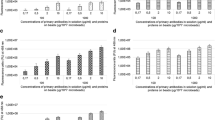Abstract
Peanuts are one of the most allergenic foods known. The presence of hidden allergens in processed food for reasons of mislabelling or cross-contamination expose allergic individuals to unpredictable risks, especially since highly sensitized subjects may experience severe anaphylactic reactions. The protection of consumers requires specific and sensitive methods for the detection of trace amounts of potentially allergenic peanut components. A rocket immunoelectrophoresis (RIE) procedure was developed allowing the detection of even spurious contaminations with peanut protein. For precipitation of peanut protein a commercially available antiserum was used. By amplifying precipitates with a secondary immunodetection step, 20 ng/ml peanut protein in chocolate extract, equivalent to 0.0002% peanut in chocolate, could still be detected. Model chocolate spiked with various amounts of peanut was investigated down to 0.001% peanut (10 ppm), the limit of quantitative determination. The method was optimized for detection of peanut in chocolate samples. Non-chocolate samples had to be standardized with a chocolate matrix prior to analysis in order to obtain a uniform response. Cross-reactivities with other food proteins did not occur. The method showed high recoveries of 85–101% for chocolate samples down to 10 ppm peanut and good reproducibility with coefficients of variation of ≤ 5 % for samples of ≥ 15 ppm peanut protein. The applicability of this method in the detection of peanut protein in various food commodities was demonstrated: two unlabelled products and two products which did not have peanut listed as an ingredient were identified as containing peanut protein. In all cases where peanut was listed, peanut protein could be determined. The results of RIE were always confirmed by those of a new cell-mediator-release assay that is based on a rat basophil leukaemia (RBL) cell-line (RBL-2H3), cells that are a functional equivalent to mucosal mast cells. Measuring the release of β-hexosaminidase resulting from cross-linking of basophil-bound peanut-specific immunoglobulin E, the assay mimics a main event of the allergic type-I reaction. The cell assay was adapted for food matrices and peanut could be detected down to 0.01% which additionally demonstrated in vitro that even trace amounts of peanut protein could elicit allergic reactions.
Similar content being viewed by others
Author information
Authors and Affiliations
Additional information
Received: 28 May 1997 / Revised version: 11 July 1997
Rights and permissions
About this article
Cite this article
Holzhauser, T., Dehne, L., Hoffmann, A. et al. Rocket immunoelectrophoresis (RIE) for determination of potentially allergenic peanut proteins in processed foods as a simple means for quality assurance and food safety. Z Lebensm Unters Forsch 206, 1–8 (1998). https://doi.org/10.1007/s002170050203
Issue Date:
DOI: https://doi.org/10.1007/s002170050203




